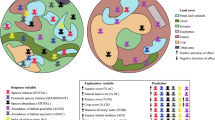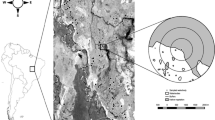Abstract
In agricultural landscapes, studies that identify factors driving species richness and occupancy are important because they can guide farmers to use conservation practices that minimize species loss. In this context, anurans are threatened by habitat loss because they depend on the characteristics of both local water bodies and adjacent landscapes. We used a model selection approach to evaluate the influence of local and landscape variables in determining anuran species richness and occurrence in 40 freshwater bodies in a heavily deforested region of semideciduous Atlantic Forest in southeastern Brazil. Our aim was to develop recommendations for conservation of anuran communities in rural areas. Pond hydroperiod and area were the most important variables for explaining anuran species richness and occupancy, with greatest species richness being found in water bodies with intermediate hydroperiod and area. Other important variables that reflected individual species occupancies were the number of vegetation types and pond isolation. In addition, recent studies evidenced that water bodies near forest fragments have higher anuran abundance or diversity. In conclusion, we suggest the maintenance of semi-permanent ponds, isolated from large rivers or reservoirs and near forest fragments, as an effective strategy to conserve anuran fauna in agricultural landscapes of southeastern Brazil. Brazilian government requires the maintenance of forests as legal reserve in each farm, and farmers need to maintain ponds as drinking water for cattle or crop irrigation. For this reason, the guidelines suggested in the present study can be easily adopted, without additional costs to rural productivity.



Similar content being viewed by others
References
Babbitt KJ, Baber MJ, Tarr T (2003) Patterns of larval amphibian distribution along a wetland hydroperiod gradient. Can J Zool 81:1539–1552
Barcha SF, Arid FM (1971) Estudo da evapotranspiração na região norte-ocidental do estado de São Paulo. Rev Cienc FCL 1:94–122
Becker CG, Fonseca CRS, Haddad CFB, Batista RF, Prado PI (2007) Habitat split and the global decline of amphibians. Science 318:1775–1778
Becker CG, Fonseca CRS, Haddad CFB, Prado PI (2010) Habitat split as a cause of local population declines of amphibians with aquatic larvae. Conserv Biol 24:287–294
Bolker BM, Brooks ME, Clark CJ, Geange SW, Poulsen JR, Stevens MHH, White J-SS (2009) Generalized linear mixed models: a practical guide for ecology and evolution. Trends Ecol Evol 24:127–135
Burnham KP, Anderson DR (2002) Model selection and inference. Springer, New York
Collins JP, Wilbur HM (1979) Breeding habits and habitats of the amphibians of the Edwin S. George Reserve, Michigan, with notes on the local distribution of fishes. Occas Pap Mus Zool, Univ Mich 686:1–33
Cushman SA (2006) Effects of habitat loss and fragmentation on amphibians: a review and prospectus. Biol Conserv 128:231–240
Dorazio RM, Royle JA (2005) Estimating size and composition of biological communities by modeling the occurrence of species. J Am Stat Assoc 100:389–398
Dorazio RM, Royle JA, Söderström B, Glimskär A (2006) Estimating species richness and accumulation by modeling species occurrence and detectability. Ecology 87:842–854
Duellman WE (1999) Distribution patterns of amphibians in the South America. In: Duellman WE (ed) Patterns of distribution of amphibians—a global perspective. Johns Hopkins University Press, Baltimore, London, pp 255–328
Gotelli NJ, Ellison AM, Dunn RR, Sanders NJ (2011) Counting ants (Hymenoptera: Formicidae): biodiversity sampling and statistical analysis for myrmecologists. Myrmecol News 15:13–19
Guerry AD, Hunter ML (2002) Amphibian distributions in a landscape of forests and agriculture: an examination of landscape composition and configuration. Conserv Biol 16:745–754
Haddad CFB, Prado CPA (2005) Reproductive modes in frogs and their unexpected diversity in the Atlantic Forest of Brazil. Bioscience 55:207–217
Hanski I (1998) Metapopulation dynamics. Nature 396:41–49
Hecnar SJ, M’Closkey RT (1997) The effects of predatory fish on amphibian species richness and distribution. Biol Conserv 79:123–131
Hecnar SJ, M’Closkey RT (1998) Species richness patterns of amphibians in Southwestern Ontario ponds. J Biogeogr 25:763–772
IUCN (2013) IUCN Red List of Threatened Species. Version 2013.1. www.iucnredlist.org. Accessed 03 July 2013
Joly CA, Rodrigues RR, Metzger JP, Haddad CFB, Verdade LM, Oliveira MC, Bolzani VS (2010) Biodiversity conservation research, training, and policy in São Paulo. Science 11:1358–1359
Knutson MG, Sauer JR, Olsen DA, Mossman MJ, Hemesath LM, Lannoo MJ (1999) Effects of landscape composition and wetland fragmentation on frog and toad abundance and species richness in Iowa and Wisconsin, USA. Conserv Biol 13:1437–1446
Legendre P (1993) Spatial autocorrelation: trouble or new paradigm? Ecology 74:1659–1673
MacKenzie D, Nichols JD, Royle JA, Pollock KH, Bailey LL, Hines JE (2006) Occupancy estimation and modeling: inferring patterns and dynamics of species occurrence. Elsevier, Burlington
Manzatto CV, Assad ED, Bacca JFM, Zaroni MJ, Pereira SEM (2009) Zoneamento agroecológico da cana-de-açúcar: expandir a produção, preservar a vida, garantir o futuro. Embrapa Solos, Rio de Janeiro
Mazerolle MJ, Desrochers A, Rochefort L (2005) Landscape characteristics influence pond occupancy by frogs after accounting for detectability. Ecol Appl 15:824–834
McCulloch CE, Searle SR (2001) Generalized, linear, and mixed models. Wiley, New York
Prado VHM, Borges RE, Silva FR, Tognolo TT, Rossa-Feres DC (2008) Amphibia, Anura, Hylidae, Phyllomedusa azurea: distribution extension. Check List 4:55–56
Provete DB, Garey MV, Silva FR, Rossa-Feres DC (2011) Anurofauna do noroeste paulista: lista de espécies e chave de identificação para adultos. Biota Neotrop 11:377–391
R Development Core Team (2012) R: a language and environment for statistical computing, reference index version 2.15.2. R Foundation for Statistical Computing, Vienna, Austria. http://www.Rproject.org. Accessed 01 July 2012
Ribeiro MC, Metzger JP, Martensen AC, Ponzoni FJ, Hirota MM (2009) The Brazilian Atlantic Forest: how much is left, and how is the remaining forest distributed? Implications for conservation. Biol Conserv 142:1141–1153
Rodrigues RR, Joly CA, de Brito MCW, Paese A, Metzger JP, Casatti L, Nalon MA, Menezes N, Ivanauskas NM, Bolzani V, Bononi VLR (2008) Diretrizes para conservação e restauração da biodiversidade no Estado de São Paulo. FAPESP, São Paulo
Rossa-Feres DC, Jim J (2001) Similaridade no sítio de vocalização em uma comunidade de anfíbios anuros na região noroeste do Estado de São Paulo, Brasil. Rev Bras Zool 18:439–454
Rossa-Feres DC, Sawaya RJ, Faivovich J, Giovanelli JGR, Brasileiro CA, Schiesari L, Alexandrino J, Haddad CFB (2011) Anfíbios do estado de São Paulo, Brasil: conhecimento atual e perspectivas. Biota Neotrop 11:1–19
Santos TG, Rossa-Feres DC, Casatti L (2007) Diversidade e distribuição espaço-temporal de anuros em região com pronunciada estação seca no sudeste do Brasil. Iheringia Ser Zool 97:37–49
Scheffer M, Van Geest GJ, Zimmer K, Butler MG, Hanson MA, Declerck S, De Meester L, Jeppesen E, Sondergaard M (2006) Small habitat size and isolation can promote species richness: second-order effects on biodiversity in shallow lakes and ponds. Oikos 112:227–231
Scott NJ, Woodward BD (1994) Surveys at breeding sites. In: Heyer WR, Donnelly MA, McDiarmid RW, Hayek LAC, Foster MS (eds) Measuring and monitoring biological diversity—standard methods for amphibians. Smithsonian Institution, Washington, DC, pp 84–92
Semlitsch RD (1998) Biological delineation of terrestrial buffer zones for pond-breeding salamanders. Conserv Biol 12:1129–1133
Semlitsch RD (2000) Principles for management of aquatic-breeding amphibians. J Widl Manag 64:615–631
Silva FR, Rossa-Feres DC (2011) Influence of terrestrial habitat isolation on the diversity and temporal distribution of anurans in an agricultural landscape. J Trop Ecol 27:327–331
Silva FR, Prado VHM, Vasconcelos TS, Santos TG, Rossa-Feres DC (2009) Amphibia, Anura, Microhylidae, Chiasmocleis albopunctata: filling gap and geographic distribution map. Check List 5:314–316
Silva FR, Prado VHM, Rossa-Feres DC (2010) Amphibia, Anura, Hylidae, Dendropsophus melanargyreus (Cope, 1887): distribution extension, new state record and geographic distribution map. Check List 6:402–404
Silva FR, Prado VHM, Rossa-Feres DC (2011a) Value of small Forest fragments to amphibians. Science 332:1033
Silva FR, Gibbs JP, Rossa-Feres DC (2011b) Breeding habitat and landscape correlates of frog diversity and abundance in a tropical agricultural landscape. Wetlands 31:1079–1087
Silva RA, Martins IA, Rossa-Feres DC (2011c) Environmental heterogeneity: anuran diversity in homogeneous environments. Zoologia 28:610–618
Silva FR, Oliveira TA, Gibbs JP, Rossa-Feres DC (2012) An experimental assessment of landscape configuration effects on frog and toad abundance and diversity in tropical agro-savannah landscapes of southeastern Brazil. Landsc Ecol 27:87–96
Smallbone LT, Luck GW, Wassens S (2011) Anuran species in urban landscapes: relationships with biophysical, built environment and socio-economic factors. Landsc Urban Plan 101:43–51
Spiegelhalter DJ, Thomas A, Best NG, Lunn D (2003) WinBUGS Version 1.4 User Manual. MRC Biostatistics Unit, Cambridge
Toledo LF, Carvalho-e-Silva SP, Sánchez C, Almeida MA, Haddad CFB (2010) A revisão do código florestal brasileiro: impactos negativos para a conservação dos anfíbios. Biota Neotrop 10:1–4
Van Buskirk J (2005) Local and landscape influence on amphibian occurrence and abundance. Ecology 86:1936–1947
Vasconcelos TS, Rossa-Feres DC (2008) Habitat heterogeneity and use of physical and acoustic space in anuran communities in Southeastern Brazil. Phyllomedusa 7:127–142
Wassens S, Hall A, Osborne W, Watts RJ (2010) Habitat characteristics predict occupancy patterns of the endangered amphibian Litoria raniformis in flow-regulated flood plain wetlands. Austral Ecol 35:944–955
Wellborn GA, Skelly DK, Werner EE (1996) Mechanisms creating community structure across a freshwater habitat gradient. Annu Rev Ecol Syst 27:337–363
Werneck FP, Gamble T, Colli GR, Rodrigues MT, Sites JW Jr (2012) Deep diversification and long-term persistence in the South American ‘dry diagonal’: integrating continent-wide phylogeography and distribution modeling of geckos. Evolution 66:3014–3034
Werner EE, Skelly DK, Relyea RA, Yurewicz KL (2007) Amphibian species richness across environmental gradients. Oikos 116:1697–1712
Zipkin EF, Royle JA, Dawson DK, Bates S (2010) Multi-species occurrence models to evaluate the effects of conservation and management actions. Biol Conserv 143:479–484
Zuur AF, Ieno EN, Elphick CS (2010) A protocol for data exploration to avoid common statistical problems. Methods Ecol Evol 1:3–14
Acknowledgments
The authors are grateful to Fernando R. Silva for help with data analyses in R and helpful comments on this version of the manuscript. While writing this paper, VHMP was supported by Fundação de Amparo à Pesquisa do Estado de São Paulo (FAPESP—Grants 2006/51534-1, 2010/50125-6). DCRF thanks FAPESP (Grant 2004/04820-3) and Conselho Nacional de Desenvolvimento Científico e Tecnológico (CNPq) for financial support.
Author information
Authors and Affiliations
Corresponding author
Appendix
Appendix
See Appendix Tables 5, 6, and 7.
Rights and permissions
About this article
Cite this article
Prado, V.H.M., Rossa-Feres, D.d.C. Multiple Determinants of Anuran Richness and Occurrence in an Agricultural Region in South-Eastern Brazil. Environmental Management 53, 823–837 (2014). https://doi.org/10.1007/s00267-014-0241-y
Received:
Accepted:
Published:
Issue Date:
DOI: https://doi.org/10.1007/s00267-014-0241-y




